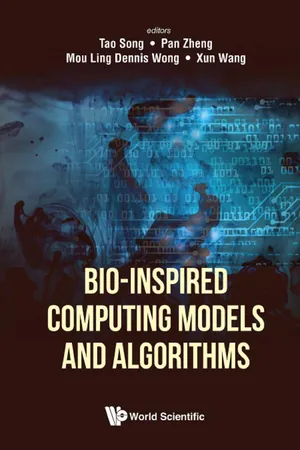
Bio-Inspired Computing Models and Algorithms
- 300 pages
- English
- ePUB (mobile friendly)
- Available on iOS & Android
Bio-Inspired Computing Models and Algorithms
About this book
Bio-inspired computing (BIC) focuses on the designs and developments of computer algorithms and models based on biological mechanisms and living phenomena. It is now a major subfield of natural computation that leverages on the recent advances in computer science, biology and mathematics.
The ideas provide abundant inspiration to construct high-performance computing models and intelligent algorithms, thus enabling powerful tools to solve real-life problems.
Written by world-renowned researchers, this compendium covers the most influential topics on BIC, where the newly-obtained algorithms, developments and results are introduced and elaborated. The potential and valuable directions for further research are addressed as well.
Contents:
- A Gentle Introduction to Membrane Systems and Their Computational Properties (Alberto Leporati, Luca Manzoni, Giancarlo Mauri, Antonio E Porreca and Claudio Zandron)
- Results on Computational Complexity in Bio-inspired Computing (Mario J Pérez-Jiménez, Agustín Riscos-Núñez, Luis Valencia-Cabrera and David Orellana-Martín)
- Integrative Approaches for Predicting microRNA Function and Prioritizing Disease-Related microRNA Using Biological Interaction Networks (Xuan Zhang and Xiangxiang Zeng)
- Evolutionary Algorithm for Solving Complex Multiobjective Optimization Problems (Ye Tian and Xingyi Zhang)
- A Bio-inspired Clustering Model for Anomaly Detection in the Mining Industry (Raymond Chiong, Zhongyi Hu, Zongwen Fan, Yuqing Lin, Stefan Chalup and Antoine Desmet)
- Picture Generating Models Based on the Splicing Operation (K G Subramanian, G Samdanielthompson and N Gnanamalar David)
- Fingerprint Minutiae to Fixed-Length Bit-String: A Review of Recent Development (Zhe Jin, Wei-Jing Wong and Andrew Beng Jin Teoh)
- Platform for Detection of Ultra-DNA Signals (10–18 mol/L) with DNA Probe and Nanomaterials (Xun Wang and Ben Hoo Mook)
- Deep Autoencoders in Pattern Recognition: A Survey (Junfen Chen, Bojun Xie, Hui Zhang and Junhai Zhai)
- Genetic Algorithm: From Promiscuity to Monogamy (Ting Yee Lim and Choo Jun Tan)
Readership: Researchers, academics and professionals in artificial intelligence, neural networks, theoretical computer science, bioinformatics and biocomputing.Bio-Inspired Computing;Nature Computing;Membrane Computing;Biometric;Bioinformatics;Neural Networks;Machine Learning00
Frequently asked questions
- Essential is ideal for learners and professionals who enjoy exploring a wide range of subjects. Access the Essential Library with 800,000+ trusted titles and best-sellers across business, personal growth, and the humanities. Includes unlimited reading time and Standard Read Aloud voice.
- Complete: Perfect for advanced learners and researchers needing full, unrestricted access. Unlock 1.4M+ books across hundreds of subjects, including academic and specialized titles. The Complete Plan also includes advanced features like Premium Read Aloud and Research Assistant.
Please note we cannot support devices running on iOS 13 and Android 7 or earlier. Learn more about using the app.
Information
Chapter 1
A Gentle Introduction to Membrane Systems and Their Computational Properties
Antonio E. Porreca§ and Claudio Zandron¶
Universit à degli Studi di Milano-Bicocca
Viale Sarca 336, Building U14, 20126 Milano, Italy
∗[email protected]
†[email protected]
‡[email protected]
§[email protected]
¶[email protected]
1.1.Introduction
1.2.Membrane Structures
Table of contents
- Cover
- Halftitle
- Title
- Copyright
- Preface
- Contents
- Chapter 1. A Gentle Introduction to Membrane Systems and Their Computational Properties
- Chapter 2. Results on Computational Complexity in Bio-inspired Computing
- Chapter 3. Integrative Approaches for Predicting microRNA Function and Prioritizing Disease-Related microRNA Using Biological Interaction Networks
- Chapter 4. Evolutionary Algorithm for Solving Complex Multiobjective Optimization Problems
- Chapter 5. A Bio-inspired Clustering Model for Anomaly Detection in the Mining Industry
- Chapter 6. Picture Generating Models Based on the Splicing Operation
- Chapter 7. Fingerprint Minutiae to Fixed-Length Bit-String: A Review of Recent Development
- Chapter 8. Platform for Detection of Ultra-DNA Signals (10–18 mol/L) with DNA Probe and Nanomaterials
- Chapter 9. Deep Autoencoders in Pattern Recognition: A Survey
- Chapter 10. Genetic Algorithm: From Promiscuity to Monogamy
- Index